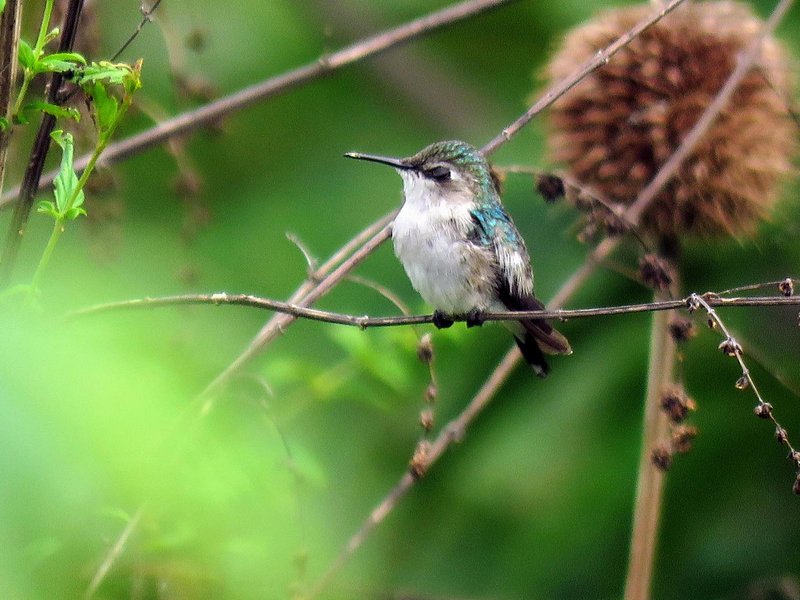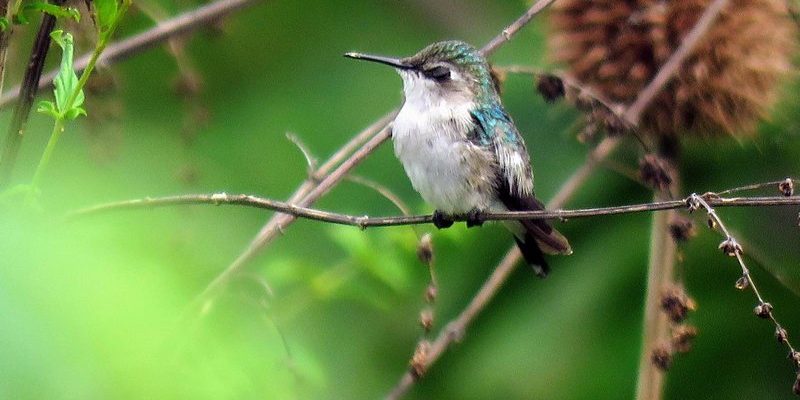
Imagine a bird so small that it could easily rest on a quarter. That’s the Bee Hummingbird, the lightest bird species on our planet. Found primarily in Cuba, this little wonder measures just around 2.0 to 2.4 inches in length. Picture yourself admiring a jewel as it flits about, its iridescent feathers shimmering in the sunlight. This petite creature doesn’t just capture the eye; it leaves us in awe with its incredible abilities and striking beauty.
The Bee Hummingbird holds the title for being the tiniest bird, but that doesn’t mean it lacks personality or skill. With a heart that beats up to 1,260 times per minute, these birds are like miniature powerhouses buzzing around their favorite flowers. As you read on, you’ll discover fascinating facts about their diet, behavior, and habitat that make them truly remarkable.
Physical Characteristics
The Bee Hummingbird is truly a sight to behold. Their size is one of the most striking features—at approximately 1.6 to 2.0 grams, they are lighter than a penny! Their feathers range in color from bright iridescent greens to vibrant blues, making them look like living gems darting through the air. Typically, males have brighter plumage, and their coloring catches the light in a way that’s almost mesmerizing.
Another fascinating feature is their wings. They can flap their wings about 80 times per second, allowing them to hover effortlessly in mid-air. This rapid wingbeat gives them incredible control and agility, making it easier for them to access nectar from flowers. Imagine trying to sip from your favorite drink while floating in the air—pretty neat, right? With their long, specialized bills, they can reach deep into blossoms that other birds can’t.
Diet and Feeding Habits
What do you think a bird that weighs less than a teabag eats? The Bee Hummingbird primarily feeds on nectar from various flowers—after all, it’s their main source of energy. They have a unique ability to see the color red, which often leads them to the vibrant blossoms they rely on for sustenance. But that’s not all; they’re also clever little foragers. They consume small insects and spiders to get the protein they need for muscle development and health.
Feeding is an art form for these birds. They can hover in place as they drink, using their long tongues to lap up nectar. This fascinating feeding technique allows them to access energy quickly, which is crucial given their high metabolism. In fact, when they feed, they can consume up to twice their body weight in nectar each day. It’s kind of like us gorging on our favorite snacks—just a bit more dramatic!
| Characteristic | Details |
| Size | 2.0 – 2.4 inches |
| Weight | 1.6 – 2.0 grams |
| Wings Beat | 80 beats per second |
| Diet | Nectar (with occasional insects) |
| Habitat | Forests and gardens in Cuba |
| Lifespan | 3 to 5 years |
Habitat and Distribution
Bee Hummingbirds are primarily found in Cuba, particularly within the lush environments of tropical and subtropical forests. They thrive in areas where there are plenty of flowers, as it provides them with ample food sources. Think about walking through a vibrant garden full of fragrant flowers; that’s the kind of place where these little birds feel at home.
In addition to their natural habitats, Bee Hummingbirds can also be found in urban areas, particularly in gardens and parks where colorful plants attract them. They are quite adaptable creatures, often adjusting their feeding routes and nesting habits based on flower availability. Isn’t it fascinating how nature allows them to thrive in various settings?
Breeding and Nesting Behavior
When it comes to breeding, Bee Hummingbirds are quite the romantics, even if their courtship rituals are brief. Males often engage in acrobatic flights to attract females—think of a dance in the sky. After successfully wooing a mate, the female takes on the responsibility of building the nest, which is typically small enough to fit in the palm of your hand. She gathers materials like leaves, cotton, and spider silk to create a cozy nook for her eggs.
The female usually lays two tiny, white eggs, which measure about the size of a pea. After about 14 to 19 days of incubation, the chicks hatch, and the mother tirelessly cares for them. She’ll feed them a diet rich in nectar and small insects, ensuring they get the nutrients needed for growth. It’s heartwarming to imagine this tiny bird protecting and nurturing her young—nature at its best!
Behavior and Social Structure
Bee Hummingbirds are generally solitary creatures, often seen darting around alone as they search for food. However, during the breeding season, some males will establish territories to attract females. They can be highly defensive, often chasing away other birds that dare to approach their chosen feeding spots or nesting areas. Think of them as the tiny bouncers of the bird world!
Despite their competitive nature, they can also be seen engaging in social interactions, especially when feeding. Groups can sometimes gather around nectar-rich blooming flowers, making for a dazzling sight as they flit and hover in close proximity. It’s a dance of sorts—birds buzzing about with enchanting colors that catches your eye. Watching them is truly a joy and a reminder of the beauty found in nature.
Conservation Status
Currently, the Bee Hummingbird is not considered endangered, thanks to its relatively stable population. However, like many other species, it faces threats from habitat loss due to deforestation and agricultural expansion. You might wonder how this charming little bird can adapt to such changes, and the truth is that while they’re opportunistic feeders, their specialized needs make them vulnerable in rapidly changing environments.
Conservation efforts focusing on preserving their natural habitats and encouraging the growth of nectar-producing plants can significantly benefit them. By planting native flowers in gardens and supporting practices that protect their ecosystems, we can contribute to the survival of these delicate creatures. After all, isn’t it wonderful to share our spaces with such captivating wildlife?
FAQs
What is the Bee Hummingbird’s size compared to other birds?
The Bee Hummingbird is the smallest bird in the world, measuring only 2.0 to 2.4 inches in length. To put this into perspective, it’s smaller than a dime! In comparison, many other hummingbird species are significantly larger, with some measuring over 5 inches in length. This size difference makes the Bee Hummingbird an extraordinary marvel of nature.
Do Bee Hummingbirds migrate?
No, Bee Hummingbirds do not migrate. They are resident birds, meaning they stay in their breeding grounds year-round. However, their movements may change based on food availability within their territory. During the dry season, they may alter their feeding routes but remain within Cuba.
How long do Bee Hummingbirds live?
On average, Bee Hummingbirds have a lifespan of about 3 to 5 years in the wild. Factors such as predation, environmental conditions, and food availability can influence their lifespan. Like many small birds, their life can be challenging, but those that thrive contribute to the beauty of their ecosystems.
What do Bee Hummingbirds eat besides nectar?
In addition to nectar, which is their primary food source, Bee Hummingbirds also consume small insects and spiders. These protein-rich foods are essential for their growth and energy needs, especially during breeding seasons when they require more nutrients to support their young.
Can you attract Bee Hummingbirds to your garden?
Yes, you can encourage the presence of Bee Hummingbirds by planting nectar-rich flowers. They are especially attracted to red and orange blooms. By creating a garden filled with native flowering plants, you increase the chances of attracting these delightful birds. Just imagine the joy of watching them hover about your flowers!
How do Bee Hummingbirds care for their young?
The female Bee Hummingbird is solely responsible for the care of her chicks. After laying two tiny eggs, she incubates them for about 14 to 19 days. Once hatched, she tirelessly feeds her young a diet of nectar and small insects until they are ready to leave the nest.
Are Bee Hummingbirds aggressive?
Yes, Bee Hummingbirds can be quite aggressive, especially males during the breeding season. They defend their territories vigorously, chasing off other birds that come too close to their chosen feeding spots. This defensiveness is a natural part of their behavior to ensure they have enough resources for themselves and their offspring.
Why are Bee Hummingbirds important to the ecosystem?
Bee Hummingbirds play a vital role in their ecosystems as pollinators. As they feed on nectar, they transfer pollen from flower to flower, helping plants reproduce. This not only benefits the plants but also supports the entire food chain, making them crucial for ecological balance. Their presence contributes to the health of various plant species and the animals that depend on them.
What are the best flowers to attract Bee Hummingbirds?
To attract Bee Hummingbirds, consider planting bright red flowers such as trumpet vine, salvia, and bee balm. These plants not only appeal to their visual preferences but also provide ample nectar. Additionally, ensuring that you have continuous blooms throughout the growing season can encourage them to visit your garden regularly.
Can Bee Hummingbirds fly backwards?
Yes, Bee Hummingbirds, like most hummingbirds, can fly backwards! Their unique wing structure allows them to rotate their wings in a figure-eight motion, granting them incredible maneuverability. This ability comes in handy when they need to retreat from potential threats while feeding or when navigating around flowers.
What colors are Bee Hummingbirds most attracted to?
Bee Hummingbirds are primarily attracted to bright colors, particularly red, orange, and pink. These colors stand out in their natural environment, signaling the presence of flowers rich in nectar. Incorporating these colors in your garden can significantly increase your chances of attracting these tiny marvels.

